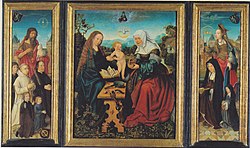Master of Delft
With Master of Delft painter Gothic is called, who was active from about 1490 and probably until around 1520 in the north of the Netherlands. The artist, not known by name, was first known as a painter, B. the side wing of an altar recognized, which the Delft mayor Dirk van Beest had commissioned from the master of Frankfurt around 1514 . He was then finally referred to as the Master of Delft because of the recurring reference to Delft in the pictures that were also assigned to him . The master uses z. B. Delft churches as background motifs or paints for donor families from the city. The local motifs shown in this way, such as B. the church Nieuwe Kerk, completed in 1496, are used to date his work.
Works (selection)
A series of three-part winged altars ( triptychs ) are attributed to the Master of Delft . Generally recognized as his work in art history are e.g. B.
- Triptych with Scenes from the Passion of Christ, The National Gallery; London, ca.1500/1510
- Triptych with the Virgin and Child and saints and donors, Rijksmuseum Amsterdam, approx. 1500–10
- Annentriptych of the Delft Van Beest family, side wing, ca.1514, Suermondt-Ludwig-Museum, Aachen
- Triptych with crucifixion scene, Wallraf-Richartz-Museum, Cologne, around 1520
Some woodcuts are also ascribed to the master of Delft .
style
Stylistically, one can recognize a relationship between the master of Delft and the master of the Virgo inter Virgines , who is also said to have worked in Delft towards the end of the 15th century. Furthermore, influences from Lucas van Leyden and his teacher Cornelis Engelbrechtsen should be recognizable in his work . E.g. the comparison with motifs and style of woodcuts by van Leyden published around 1490.
Interpretation of the compositions
The lively and popular representation of the figures in contemporary costume and bourgeois splendor z. B. in the crucifixion scenes of the master of Delft shows the proximity of his interpretation of the Christian motifs to the calls for life in proximity and following Christ represented by Thomas von Kempen , a teaching that had become popular in the Delft region and also in the Choice of motifs by other contemporary painters can be seen. The more prominent involvement of the founders and their families in the overall composition also begins at this time, which begins to show the people's closer proximity to the divine and sacred.
Web links
- National Gallery, London Triptych with scenes of the Passion of Christ
- Rijksmuseum Amsterdam Triptych with Virgin and Child and saints and donors
- Master of Delft at Google Arts & Culture
Individual evidence
- ^ MJ Friedländer: In: The Burlington Magazine . 1913 (still referred to as the makeshift name Master of the Brownlow Triptych after a London work).
- ^ C. Vogt: Meister von Frankfurt, Meister von Delft: the Annentriptychon the Delft Van Beest family in the Suermondt-Ludwig-Museum. Museums of the City of Aachen 2002.
- ↑ a b M. J. Friedländer: Old Dutch painting. Volume 10: Lucas van Leyden and other Dutch masters of his time. P. Cassirer, Berlin 1932.
- ↑ Master of Delft . In: Hans Vollmer (Hrsg.): General lexicon of fine artists from antiquity to the present . Founded by Ulrich Thieme and Felix Becker . tape 37 : Master with emergency names and monogramists . EA Seemann, Leipzig 1950, p. 78 .
- ↑ Master of Delft. In: The Concise Grove Dictionary of Art. Oxford University Press, Oxford 2002.
| personal data | |
|---|---|
| SURNAME | Master of Delft |
| BRIEF DESCRIPTION | Gothic painter |
| DATE OF BIRTH | before 1496 |
| DATE OF DEATH | 16th Century |
